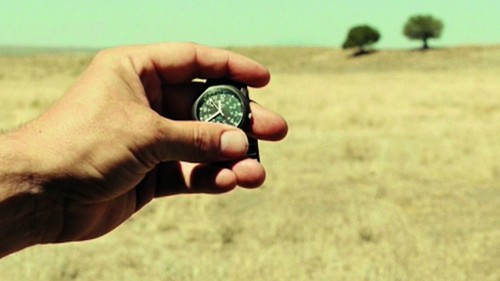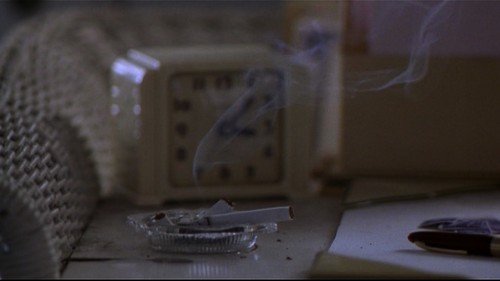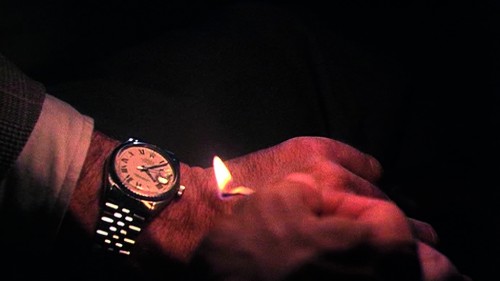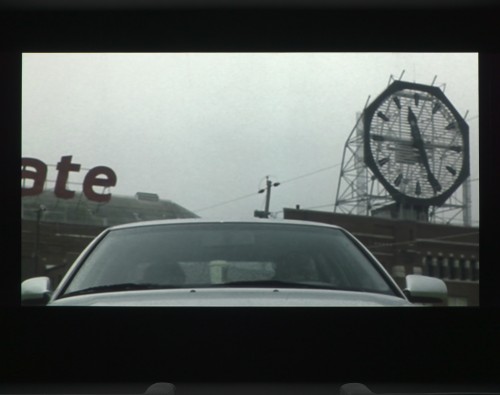
Christian Marclay, video still from “The Clock,” 2010. Single-channel video with sound, 24 hours. © Christian Marclay. Courtesy Paula Cooper Gallery, New York.
The trick, intelligently applied, today allows us to make visible the supernatural, the imaginary, even the impossible. —Georges Méliès
As a professor of modern and contemporary art history I have found myself on more than a few occasions defending, justifying or otherwise explaining a work or exhibition of contemporary art that has left friends confounded, exasperated, or both. In truth, I can sympathize with their plight. To my mind, the best contemporary art is that which is both conceptually rigorous and visually compelling, but more often than not it seems that the former is emphasized at the expense of the latter. Every once in a while, however, there comes along a work that so succinctly and accessibly coalesces some of the grand themes and concerns of art and art theory while presenting them with such wit and virtuosity that it stands as a tour de force of contemporary art. Christian Marclay’s The Clock (2010), currently on view at the Museum of Modern Art in New York, is one such work.

Christian Marclay, video still from “The Clock,” 2010. Single-channel video with sound, 24 hours. © Christian Marclay. Courtesy Paula Cooper Gallery, New York.
The Clock is a cinematic wonder: a twenty-four hour film that unfolds in real time. A deftly edited montage of film segments, culled from the deepest reaches of the history of cinema, The Clock consists of thousands of appropriated film clips in which a clock or watch is usually visible somewhere in the shot. Marclay, who was born in California in 1955 and raised in Switzerland, then sequenced the clips in chronological order, so that each minute of his film is comprised of segments that include a reference to or otherwise transpires in the corresponding minute of a 24-hour cycle. In other words, The Clock is synched to real-world time, so that if you happen to be watching it at 11:38 in the morning, the sequence of shots in the film will include timepieces displaying the same time, 11:38AM. As your phone or wristwatch ticks over to 11:39 so do the clocks on the big screen.
For film aficionados The Clock offers a chance to revel in hundreds of notable cinematic moments in which time plays an integral role in the narrative: high noon in, well, High Noon, for example, or the precise time that lightning strikes the courthouse clock tower in Back to the Future (10:04PM). If you are watching at 11:40AM you can witness Lola begin her frantic twenty-minute dash to come up with 100,000 German marks to save her boyfriend in Run Lola Run, and if you stay for another five minutes you will see the infamous scene from Quentin Tarantino’s Pulp Fiction in which Christopher Walken’s character tells the backstory behind Butch’s watch, which, when presented to the child, displays the time 11:45. But Marclay has also excerpted thousands of film segments in which time is largely incidental, wherein the clock on the mantel in the background or on the bedside table is but one minor prop among many, or a protagonist casually mentions the time at which a guest is expected to arrive. Big Ben makes countless cameos in the background of scenes, and bus and train station clocks are plentiful.

Christian Marclay, video still from “The Clock,” 2010. Single-channel video with sound, 24 hours. © Christian Marclay. Courtesy Paula Cooper Gallery, New York.
The truly remarkable thing about Marclay’s The Clock is the deft coordination of one shot with the next, wherein the artist often exploits rhythmic and graphic relationships (continuities in composition, setting, figure movement, camera movement, etc.) to link unrelated film segments together. Eyeline matches, whereby an actor is seen looking at something off screen and then the next shot shows what is being looked at, are employed to create a sense of spatial and narrative continuity where clearly non exist—a protagonist in a black and white shot looking offscreen cutting to a shot of a wall clock in a color film, for example. Other examples of edits that infer a sense of conceptual and at times narrative cohesion include sequences of beach scenes strung together, or a scene of a bank heist with a large clock in the background giving way to a robber clearing valuables off of a mantelpiece, upon which sits a clock displaying the same time as the bank’s.

Christian Marclay, video still from “The Clock,” 2010. Single-channel video with sound, 24 hours. © Christian Marclay. Courtesy Paula Cooper Gallery, New York.
As with most films, sound in The Clock is also employed to produce a sense of continuity between shots and to shape how we perceive the visual elements. Marclay employs sound bridges throughout to create smooth transitions and set up viewer expectations, as sound from the last scene lingers into the next (most consistently in the form of church bells ringing and clocks ticking). One striking example of an effective sound bridge occurs at 1:30AM, when the group of high school misfits from The Breakfast Club is seen whistling a marching tune (included in Marclay’s film on account of the large clock on the back wall of the library/detention hall). Anyone familiar with John Hughes’s 1985 classic remembers that when Assistant Principal Richard (Dick) Vernon walks into the room, all of the students stop whistling except for John Bender (played by Judd Nelson), who instead whistles the portentous opening notes of Beethoven’s 5th symphony to signal the entrance of his nemesis and the end of their detention-hall fun.
In The Clock, the tune whistled by Bender bridges over into the next scene, a black and white shot in which a visibly frightened and anxious woman is sitting by a phone. A nearby clock dutifully displays the time. Bender’s whistling of Beethoven’s famously dramatic four-note opening motif is heard as the startled woman’s phone rings, wryly amplifying the scene’s foreboding and suspenseful mood. This interplay between sound and image creates a powerful sense of continuity between entirely disparate film segments, and is but one of countless technical achievements that make The Clock’s brisk transitions seem seamless and unobtrusive. Indeed, one of the many visceral and conceptual pleasures of watching Marclay’s film is enjoying the way he uses such sound and visual continuities to convey information and suggest causal relationships where none exist. The film’s form begins to make us aware of just how strongly editing shapes our viewing experience, inviting our complicity in constructing narratives and projecting meaning—and even a sense of denouement—onto the snippets of events unfolding before us.

Christian Marclay, video still from “The Clock,” 2010. Single-channel video with sound, 24 hours. © Christian Marclay. Courtesy Paula Cooper Gallery, New York.
Filled with conceptual jokes and self-conscious moments, The Clock is a mesmerizing masterpiece. But it is much more. For while it thematizes the passage of time we are also made deeply aware of its passing. Rather than a traditional film in which there is a suspension of real time, time’s unfolding here becomes a palpable part of our filmic experience. In Marclay’s hands, time exists both in the context of its filmic representation and in the way that it imposes itself on us as an objective reality. Time becomes both structuring principle and inescapable event, as the thing itself and its representation collapse together and cinematic and real time merge into one. More than an homage to film history and a wry piece of conceptualism, The Clock spectacularly reinvents one of Western art’s most enduring motifs, the memento mori: a reminder of time’s inexorable march and of the inevitability of death. It is a point driven home throughout, and also by the simple fact that The Clock is running before we enter the theater and continues on in our absence. Marclay’s film isn’t just marking time, it is marking our modern age, structured and calibrated as it is by mechanical and increasingly digital standards. The Clock is a sight to behold, and is so utterly compelling that you could easily find yourself watching it for two hours or more, assuming, of course, that you have the time to spare.
Christian Marclay—The Clock is on view at the Museum of Modern Art through January 21, 2012.




Pingback: On View Now | Christian Marclay's “The Clock” | Art21 Blog | ChristianBookBarn.com
Pingback: Alchemy of Inspiration I Looking Ahead to 1993… | Art21 Blog
Pingback: Time Waits For No One: Christian Marclay’s The Clock at SFMOMA | Venetian Red Art Blog